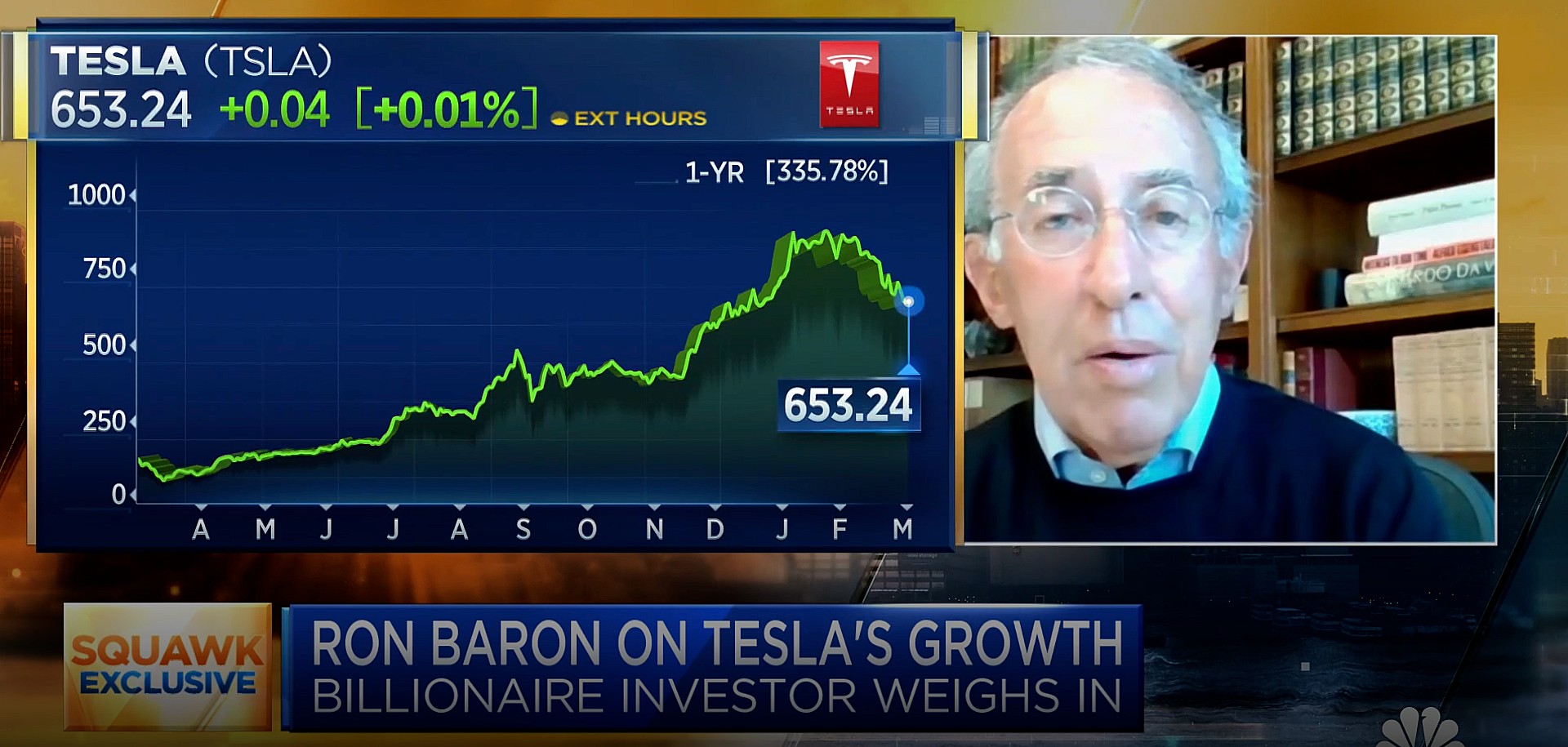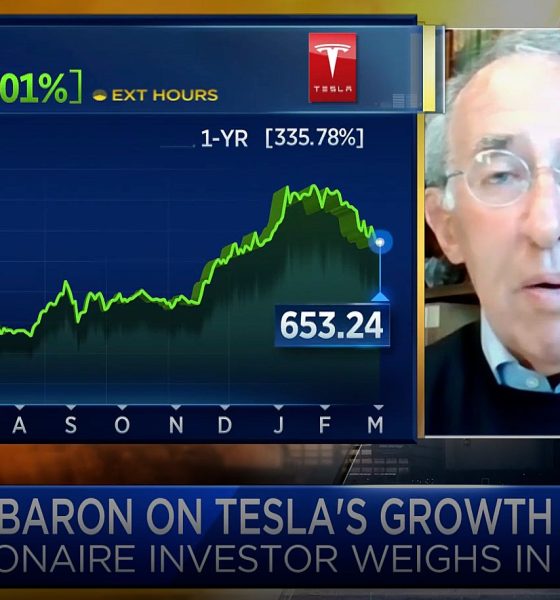

Investor's Corner
Tesla bull Baron Capital sells 1.8M shares, Ron Baron’s personal shares remain untouched
Tesla (NASDAQ: TSLA) bull Ron Baron and his investment firm Baron Capital have been some of the biggest supporters of Elon Musk’s electric car company. Baron Capital, however, has sold 1.8 million TSLA shares over the past six months, Ron Baron said, due to portfolio concentration. The billionaire investor remains bullish on Tesla, revealing that his personal 1.1 million shares haven’t been sold, and none of them will be for at least a decade.
“In the past six months, we have sold about 1.7 million out of our 8 million shares that we held. We sold them between $450 and $900, an average of $666.70. So, we still own 75% of our stock, actually, more than 75%,” Baron told CNBC. Baron still maintains a $2,000 price target per share for ten years in the future, and believes it “could be light by $500 or $1,000.”
Interestingly, if Baron feels that Tesla is still going up, why would his firm decide to sell shares. Ultimately, it comes down to portfolio concentration, and Tesla’s meteoric rise in 2020, which saw the stock price surge over 700%, caused some accounts to become too heavily concentrated in Tesla stock. Portfolio diversity is important, especially for large fund managers, who are investing client’s money based on trust.
Baron Capital made the decision to sell because “it was up 20 times,” Baron said. “It became a very large percentage of some accounts.” Despite Baron Capital’s decision to sell for its clients, Ron Baron stated that his personal ownership stake in Tesla hasn’t budged, and it won’t for at least ten years.
ALSO READ:
Tesla purchases using Bitcoin are coming as EV maker invests $1.5B in cryptocurrency
“I happen to own 1,115,000 shares personally. I haven’t sold a single share, and I don’t expect to for ten years,” Baron added. “But, for clients, I sold 27% or 25% of their stock. I told Elon, ‘I was the last one in, I bought it for all my clients first.’ And in 2016, when I was totally filled on the accounts that I could buy for at our firm, I couldn’t convince other people to buy more, then I invested for in my firm into this company [Tesla], and I think I’m going to hold it for another ten years, at least.”
Baron said that Tesla holdings became more than 50% of two focused funds at Baron Capital and it became a risk management issue. Instead, Baron has invested in several other automotive companies, including Rivian, which is currently still a privately owned company, and Cruise, an autonomous vehicle company that is majority-owned by General Motors. Baron Capital bought more than 1.2 million shares in Janary for $10 million, he said.
While keeping some of the investments behind closed doors, Baron did say that several other EV startups are driving his speculation of the evergrowing market. However, he admits that not all of them will succeed. “If you think all these companies starting up are going to make it, I think it’s a dream. I think it’s astonishing they’re getting so much capital.”
Baron’s interview with CNBC is available below.
Disclosure: Joey Klender is a TSLA Shareholder.

Investor's Corner
Tesla stock closes at all-time high on heels of Robotaxi progress

Tesla stock (NASDAQ: TSLA) closed at an all-time high on Tuesday, jumping over 3 percent during the day and finishing at $489.88.
The price beats the previous record close, which was $479.86.
Shares have had a crazy year, dipping more than 40 percent from the start of the year. The stock then started to recover once again around late April, when its price started to climb back up from the low $200 level.
This week, Tesla started to climb toward its highest levels ever, as it was revealed on Sunday that the company was testing driverless Robotaxis in Austin. The spike in value pushed the company’s valuation to $1.63 trillion.
Tesla Robotaxi goes driverless as Musk confirms Safety Monitor removal testing
It is the seventh-most valuable company on the market currently, trailing Nvidia, Apple, Alphabet (Google), Microsoft, Amazon, and Meta.
Shares closed up $14.57 today, up over 3 percent.
The stock has gone through a lot this year, as previously mentioned. Shares tumbled in Q1 due to CEO Elon Musk’s involvement with the Department of Government Efficiency (DOGE), which pulled his attention away from his companies and left a major overhang on their valuations.
However, things started to rebound halfway through the year, and as the government started to phase out the $7,500 tax credit, demand spiked as consumers tried to take advantage of it.
Q3 deliveries were the highest in company history, and Tesla responded to the loss of the tax credit with the launch of the Model 3 and Model Y Standard.
Additionally, analysts have announced high expectations this week for the company on Wall Street as Robotaxi continues to be the focus. With autonomy within Tesla’s sights, things are moving in the direction of Robotaxi being a major catalyst for growth on the Street in the coming year.
Elon Musk
Tesla needs to come through on this one Robotaxi metric, analyst says
“We think the key focus from here will be how fast Tesla can scale driverless operations (including if Tesla’s approach to software/hardware allows it to scale significantly faster than competitors, as the company has argued), and on profitability.”

Tesla needs to come through on this one Robotaxi metric, Mark Delaney of Goldman Sachs says.
Tesla is in the process of rolling out its Robotaxi platform to areas outside of Austin and the California Bay Area. It has plans to launch in five additional cities, including Houston, Dallas, Miami, Las Vegas, and Phoenix.
However, the company’s expansion is not what the focus needs to be, according to Delaney. It’s the speed of deployment.
The analyst said:
“We think the key focus from here will be how fast Tesla can scale driverless operations (including if Tesla’s approach to software/hardware allows it to scale significantly faster than competitors, as the company has argued), and on profitability.”
Profitability will come as the Robotaxi fleet expands. Making that money will be dependent on when Tesla can initiate rides in more areas, giving more customers access to the program.
There are some additional things that the company needs to make happen ahead of the major Robotaxi expansion, one of those things is launching driverless rides in Austin, the first city in which it launched the program.
This week, Tesla started testing driverless Robotaxi rides in Austin, as two different Model Y units were spotted with no occupants, a huge step in the company’s plans for the ride-sharing platform.
Tesla Robotaxi goes driverless as Musk confirms Safety Monitor removal testing
CEO Elon Musk has been hoping to remove Safety Monitors from Robotaxis in Austin for several months, first mentioning the plan to have them out by the end of 2025 in September. He confirmed on Sunday that Tesla had officially removed vehicle occupants and started testing truly unsupervised rides.
Although Safety Monitors in Austin have been sitting in the passenger’s seat, they have still had the ability to override things in case of an emergency. After all, the ultimate goal was safety and avoiding any accidents or injuries.
Goldman Sachs reiterated its ‘Neutral’ rating and its $400 price target. Delaney said, “Tesla is making progress with its autonomous technology,” and recent developments make it evident that this is true.
Investor's Corner
Tesla gets bold Robotaxi prediction from Wall Street firm
Last week, Andrew Percoco took over Tesla analysis for Morgan Stanley from Adam Jonas, who covered the stock for years. Percoco seems to be less optimistic and bullish on Tesla shares, while still being fair and balanced in his analysis.

Tesla (NASDAQ: TSLA) received a bold Robotaxi prediction from Morgan Stanley, which anticipates a dramatic increase in the size of the company’s autonomous ride-hailing suite in the coming years.
Last week, Andrew Percoco took over Tesla analysis for Morgan Stanley from Adam Jonas, who covered the stock for years. Percoco seems to be less optimistic and bullish on Tesla shares, while still being fair and balanced in his analysis.
Percoco dug into the Robotaxi fleet and its expansion in the coming years in his latest note, released on Tuesday. The firm expects Tesla to increase the Robotaxi fleet size to 1,000 vehicles in 2026. However, that’s small-scale compared to what they expect from Tesla in a decade.
Tesla expands Robotaxi app access once again, this time on a global scale
By 2035, Morgan Stanley believes there will be one million Robotaxis on the road across multiple cities, a major jump and a considerable fleet size. We assume this means the fleet of vehicles Tesla will operate internally, and not including passenger-owned vehicles that could be added through software updates.
He also listed three specific catalysts that investors should pay attention to, as these will represent the company being on track to achieve its Robotaxi dreams:
- Opening Robotaxi to the public without a Safety Monitor. Timing is unclear, but it appears that Tesla is getting closer by the day.
- Improvement in safety metrics without the Safety Monitor. Tesla’s ability to improve its safety metrics as it scales miles driven without the Safety Monitor is imperative as it looks to scale in new states and cities in 2026.
- Cybercab start of production, targeted for April 2026. Tesla’s Cybercab is a purpose-built vehicle (no steering wheel or pedals, only two seats) that is expected to be produced through its state-of-the-art unboxed manufacturing process, offering further cost reductions and thus accelerating adoption over time.
Robotaxi stands to be one of Tesla’s most significant revenue contributors, especially as the company plans to continue expanding its ride-hailing service across the world in the coming years.
Its current deployment strategy is controlled and conservative to avoid any drastic and potentially program-ruining incidents.
So far, the program, which is active in Austin and the California Bay Area, has been widely successful.








